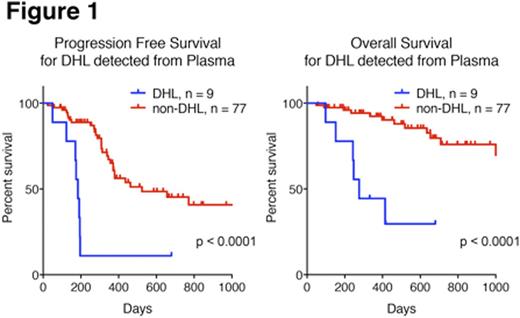Abstract
Background: Diffuse large B cell lymphoma (DLBCL) is a clinically heterogeneous disease, where almost half of patients fail to fully respond to therapy and have poor outcomes. Prognostic molecular markers, including translocations in BCL2, BCL6, and MYC, can help identify patients at high risk for treatment failure. However, these markers rely on diagnostic tumor samples which must be obtained invasively and are not universally available. Circulating tumor-specific DNA (ctDNA) could provide a source of material for detection of these translocations directly from the blood. We sought to examine the performance for detection of these translocations from ctDNA, as well as their association with eventual clinical outcomes.
Methods: We profiled tumor and plasma samples from patients with DLBCL receiving combination immunochemotherapy at Stanford University and MD Anderson Cancer Center. As the clinical gold standard, tumor samples were assessed with break-apart fluorescence in situ hybridization (FISH) to detect breaks in BCL2, BCL6, and MYC. DNA from tumor and plasma samples was then sequenced using CAPP-Seq, a targeted next-generation sequencing based method for detection of ctDNA (Newman AM et al, Nature Medicine 2014). Translocations were identified from paired-end reads using FACTERA (Newman AM et al, Bioinformatics 2014). We compared the technical performance of our sequencing-based approach to FISH from tumor samples. Finally, we assessed the prognostic value of our method in relation to clinical outcomes.
Results: We prospectively enrolled 86 patients with DLBCL as two cohorts, either at Stanford University (n=40) or at MD Anderson Cancer Center (n=46). We first profiled tumor samples from 40 patients (Stanford cohort) for translocations using FISH as part of the clinical standard of care, identifying 24 translocations in total (12 in BCL2, 7 in BCL6, and 5 in MYC). All patients had tumor and plasma available for sequencing. By analyzing DNA from tumor samples with CAPP-Seq, we identified 92% of all translocations previously identified by FISH (11/12 BCL2, 7/7 BCL6, 4/5 MYC). Furthermore, without prior knowledge of tumor genotypes, we were able to identify 79% (19/24) translocations directly from the plasma (10/12 BCL2, 4/7 BCL6, 5/5 MYC). The performance of genotyping translocations from ctDNA improved with increasing tumor burden, such that 95% (19/20) of translocations were detected in samples with >16pg/mL (e.g. 5 genome equivalents/mL) of ctDNA. We next validated the performance of noninvasive genotyping for translocations in an independent cohort of 46 pretreatment plasma samples (MD Anderson Cancer Center cohort). In patients with detectable ctDNA, we successfully identified 78% (18/23) of translocations previously seen by FISH. Furthermore, in two patients, we detected translocations previously missed by FISH from FFPE tissue specimens (BCL6-IGH and MYC-IGH). In addition to known translocation partners, we observed several novel partner genes for MYC (e.g. PTMA and 7p15.2) and BCL6 (e.g. IRF1). Importantly, across both cohorts, we identified 82% (9/11) of patients with both MYC and BCL2/BCL6 translocations (double-hit lymphoma, DHL) directly from the plasma without knowledge of the tumor. Moreover, DHL detected noninvasively significantly predicted both progression-free and overall survival (p<0.0001, Figure 1).
Conclusions: Identification of translocations from plasma without tissue samples is feasible with high sensitivity for all clinically relevant genes. Detection of translocations from plasma is prognostic of eventual outcomes, including overall survival. This technique has potential clinical utility in patients without easily accessible tissue, as well as for monitoring evolution of tumor genotypes over time.
Newman:Roche: Consultancy. Levy:Kite Pharma: Consultancy; Five Prime Therapeutics: Consultancy; Innate Pharma: Consultancy; Beigene: Consultancy; Corvus: Consultancy; Dynavax: Research Funding; Pharmacyclics: Research Funding. Westin:Celgene: Membership on an entity's Board of Directors or advisory committees; Chugai: Membership on an entity's Board of Directors or advisory committees; Spectrum: Membership on an entity's Board of Directors or advisory committees; ProNAi: Membership on an entity's Board of Directors or advisory committees. Diehn:Roche: Consultancy; Novartis: Consultancy; Quanticel Pharmaceuticals: Consultancy; Varian Medical Systems: Research Funding.
Author notes
Asterisk with author names denotes non-ASH members.


This feature is available to Subscribers Only
Sign In or Create an Account Close Modal